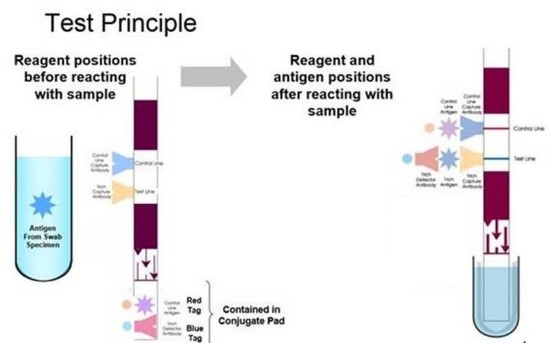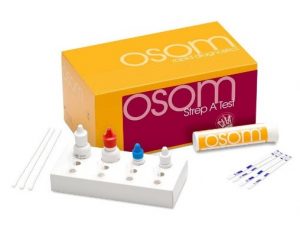 Group A Streptococcus (Strep A) is one of the most important causes of acute upper respiratory tract infection. “Early diagnosis and treatment of Group A Streptococcal pharyngitis has been shown to reduce the severity of symptoms and further complications such as rheumatic fever and glomerulonephritis. “
Group A Streptococcus (Strep A) is one of the most important causes of acute upper respiratory tract infection. “Early diagnosis and treatment of Group A Streptococcal pharyngitis has been shown to reduce the severity of symptoms and further complications such as rheumatic fever and glomerulonephritis. “
Current Strep A Testing Methods
Labs have traditionally used conventional identification procedures for Group A Streptococcus from throat swabs, which involve the isolation and subsequent identification of viable pathogens by culture techniques that require 18-24 hours or longer.
The Centor score is also used by physicians in the diagnosis of Group A Streptococcus. Centor scores evaluate a set of clinical patient criteria to determine the likelihood of a bacterial infection.
Rapid Antigen Tests (RATs) detect either viable or nonviable organisms directly from a throat swab - providing results within 5 minutes.
What is a Lateral Flow Rapid Antigen Test?
In many parts of the world, Lateral Flow Rapid Antigen Tests (RAT’s) are a well-established technology for point of care testing. They are referred to by a number of names, including:
- Lateral flow test (LFT)
- Lateral flow device (LFD)
- Lateral flow assay (LFA)
- Lateral flow immunoassay (LFIA)
- Lateral flow immunochromatographic assays
- Test strip
- Rapid test
Using an RAT to test for a Strep A infection provides many benefits over both conventional lab tests and Centor scores:
- Reduces time to diagnosis
- Allows for more accurate prescribing of medications
- Immediate treatment can help control the spread of disease
- Requires minimal training to operate and can be performed in the lab or the doctor’s office.
How Does a Lateral Flow Rapid Antigen Test for Group A Strep Work?
The patient’s throat swab collects a carbohydrate antigen unique to Group A Strep (GAS) from the tonsils, which is extracted into a liquid reagent. When the dipstick is added, the reagent flows up the stick by capillary action. If GAS is present in the sample, it will initially form a complex with Anti-GAS Antibody conjugated colour particles in the sample (conjugate) pad. As the liquid continues to flow up the stick this complex is then bound by a capture antibody immobilised on the strip (“sandwich”) – forming a visible, coloured line.

Test Performance Standards Matter
In principle, the technology behind the test appears simple. Both doctors and patients often assume that all tests on the market perform similarly.
However, not all tests meet the most rigorous performance standards. That’s why you’ll want to give careful consideration to selecting the best Strep A rapid test for your patients. Here’s how you can tell the difference between test options.
How to Choose the Right Test for Your Patients
You will need to look at several things when choosing a point-of-care Rapid Antigen Test. Tests should have gone through a clinical study to show various measures of product performance, as detailed in the Instructions for Use (IFU). When you evaluate the data, you’ll want to look at:
- Sample size and type
Ensure that studies used large numbers of fresh patient samples - rather than frozen or stored samples. - When the study was conducted
Patient samples should have been collected during an actual strep season, and sourced from multiple clinical sites. - The comparative method
It is vital to select the right method against which to compare Sensitivity and Specificity. It should be an established ‘Gold Standard’ such as culture. One rapid antigen test should not be compared only against another rapid antigen test, as this may not give the full picture of the test’s performance.
In addition:
- You should critically review any claims made by manufacturers regarding their performance, and request supporting evidence.
- Compliance with FDA and CLIA performance requirements can give you some assurance on the quality of the clinical studies used – but not all tests available on the market are in compliance with FDA & CLIA requirements.
- The availability of control materials is important for Quality Control testing at your site & reviewing test performance in External Quality Assurance / Proficiency Testing Schemes can be helpful.
Measures of Rapid Antigen Test Product Performance
You can find the sensitivity and specificity results in the IFU that accompanies the test. A good RAT should have both high sensitivity and high specificity.
- Sensitivity- Sensitivity is the percentage of people who have the disease that are detected by the test.
Therefore, it is critical that you select a test with a high diagnostic sensitivity, as the higher the sensitivity of a product, the fewer false negatives it will have.
- Specificity- Specificity is the number of negatives detected by the rapid test in comparison to true negatives – expressed as a percentage. The higher the specificity of a product, the fewer false positives it will have.
Sensitivity and Specificity are used to calculate two important factors – Positive Predictive Value (PPV) and Negative Predictive Value (NPV).
- A high PPV is important, because it shows the percentage of patients with a positive result that actually have the disease. This helps you to be more confident that the test is accurately diagnosing a patient as having Strep A - thus requiring antibiotics or further referral for treatment.
- A high NPV allows you to confidently rule out Strep A, as it reflects the probability that a person with a negative result does not have the disease.
In the physician’s office, it is more likely you will need to rule out Strep A than rule it in. Studies show that as few as 5-30% of patients presenting with sore throat actually have Strep A infection and would need an antibiotic. According to the IDSA (Infectious Diseases Society of America):
“About 15 million people in the U.S. see the doctor for a sore throat every year and up to 70 percent receive antibiotics, although only a smaller percentage actually have strep throat: approximately 20 to 30 percent of children and just 5 to 15 percent of adults.”
Risks Associated with Lower Quality Rapid Strep A Tests at the Point-of-Care
The implications of selecting a lower quality test are significant. Incorrect diagnosis – False Positives or False Negatives – could lead to:
- Unnecessary prescribing of antibiotics
- Not prescribing antibiotics when needed, leading to far more serious health issues
- Patient dissatisfaction
Selecting the Right Strep A Rapid Test
 Although there are many manufacturers supplying Rapid Antigen Tests for Strep A, the tests can vary significantly in cost and performance quality. Be sure that you review the performance data, particularly sensitivity and specificity, and the quality of the study used to generate that data. High sensitivity and specificity provide good PPV & NPV. Without them, the test you may be considering offers little value.
Although there are many manufacturers supplying Rapid Antigen Tests for Strep A, the tests can vary significantly in cost and performance quality. Be sure that you review the performance data, particularly sensitivity and specificity, and the quality of the study used to generate that data. High sensitivity and specificity provide good PPV & NPV. Without them, the test you may be considering offers little value.



Share Article